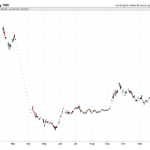This article delves into the daily prices of silver in 1991, providing a historical insight into the fluctuations of silver prices over the course of the year. The data covers a period of five months, from January to June and then from July to December, and includes weekends and holidays. The London Bullion Market Association conducted silver price auctions, and the prices are recorded in US dollars per troy ounce.
While the data is not adjusted for inflation, it provides a valuable resource for historical research and analysis. The fluctuations in silver prices over the course of 1991 are of particular interest to economists, investors, and historians, as they reflect the economic and political climate of the time.
This article aims to provide an objective and analytical overview of the price data, highlighting the key fluctuations and discussing their potential implications. By examining the daily silver prices in 1991, readers can gain a better understanding of the factors that influenced the market and the broader economic trends of the time.
Price Data Overview
An overview of the price data for silver in 1991 reveals a range of fluctuations throughout the months, with prices ranging from $3.82 to $4.45 per ounce and no adjustments made for inflation, providing historical insight for research purposes.
This data can be compared with current market trends to identify any significant changes in the price of silver over time. Moreover, it is essential to consider the impact of geopolitical events on the price of silver during this period. While the data does not provide any information about the events that may have affected the price of silver, it can be used to identify any correlations between the price of silver and geopolitical events.
It is important to note that the data covers a span of five months and includes weekends and holidays, which may have affected the price of silver. The data does not provide any information about the demand or supply of silver during this period, which can also impact the price.
However, the data does provide an objective and analytical view of the silver prices in 1991, which can be used for research purposes. By comparing this data with current market trends and considering geopolitical events, researchers can gain a better understanding of the factors that influence the price of silver over time.
Silver Price Fluctuations
The fluctuations in price of silver during the second half of 1991 reflect the dynamic nature of the precious metals market. The prices of silver ranged from $3.82 to $4.45 per ounce, and there were noticeable fluctuations throughout the months.
To fully understand these fluctuations, it is important to analyze the demand, market conditions, and supply during 1991, as well as the factors that affected silver prices during this time period.
During 1991, global demand for silver was high due to its use in industrial applications, particularly in the electronics and photography industries. Market conditions were also influenced by the ongoing Gulf War, which created uncertainty in the financial markets and increased demand for safe-haven assets such as silver.
Furthermore, the supply of silver was limited due to reduced mining activity and a decrease in scrap metal recycling. These factors, along with other geopolitical and economic events, contributed to the fluctuations in silver prices during the second half of 1991.
Usefulness for Historical Research
This dataset of daily silver price data from 1991, including LBMA silver price fix history data, may be valuable for researchers conducting historical analyses of the precious metals market during this time period. The data covers a span of 5 months and includes a total of 100 prices, presented in chronological order, which can be useful for tracking the fluctuations in silver prices over this period.
Furthermore, the data may provide insights into the impact of market conditions on the economy and the demand and supply of silver during this time. However, it is important to note that the prices are not adjusted for inflation and cannot be directly compared to current silver prices.
For researchers interested in studying the precious metals market during the early 1990s, this dataset can provide a useful reference point. By examining the fluctuations in silver prices over this period, researchers can gain insights into the market conditions, demand, and supply of silver during this time.
However, it is important to keep in mind that the prices are not adjusted for inflation, and therefore, any comparison to current silver prices should be done with caution. Nonetheless, this dataset can serve as a valuable resource for researchers interested in conducting historical analyses of the precious metals market in the early 1990s.
Frequently Asked Questions
What was the industrial demand for silver in 1991?
The industrial demand for silver in 1991 was influenced by various silver demand drivers, including electronics and photography industries. Market competition also affected the demand, as substitutes such as copper and aluminum became more prevalent in certain industries.
How did the political and economic events of the time affect the silver market?
Political instability and economic recessions can have a significant impact on silver prices. In 1991, the Gulf War and economic downturns in several countries likely contributed to fluctuations in the silver market. Objective analysis of data can provide valuable insights into these effects.
What were the key players in the silver market during this time period?
During the period of 1991, the silver market players included various trading banks and brokerages, with the London Bullion Market Association conducting silver price auctions. Influential figures were not identified, and there is no available information on market competition, trends, analysis, or innovations.
How did the price of silver compare to other precious metals during this time?
When comparing commodities, silver was outperformed by gold, platinum, and palladium in 1991. However, silver still had investment potential due to its industrial uses and global demand.
What impact did inflation have on the price of silver in 1991?
The impact of global trade and silver mining production on the price of silver in 1991 was significant. Inflation played a role in price fluctuations, but other factors such as supply and demand and market conditions also influenced the price. A data-driven analysis is necessary to fully understand the complex dynamics at play.





